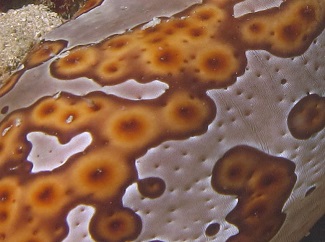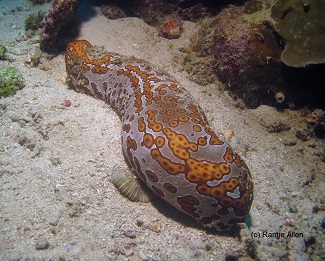Loading content - please wait...
Leopard sea cucumber self-mutilates
Leopard sea cucumber is a beautiful creature of the ocean floor. However, divers should avoid touching its sensitive body.
Spotted Beauty
The Leopard sea cucumber lives in the eastern Indian and the western Pacific oceans. In the areas we dive in Gorontalo, it can only be found dependably at a single dive site. This sea cucumber lives in sandy areas, flanked by coral reef. Researchers say that it lives from three to almost forty meters deep. We usually find it between 15 and 18 meters here.
Although research claims it can grow to 60 centimeters, those in Gorontalo measure only half of that length. Divers can easily identify the Leopard cucumber. Its spotted pattern is distinctive and unmistakable. The tubular body is grey but sprinkled with random rows spots. These spots are orange and edged in brown.
Avoid Touching
Leopard sea cucumber is highly sensitive. It considers touching, grabbing, or lifting to be a threat. When threatened, it will eject white strings. These elongate in sea water. They also become sticky. Scientists consider this behavior to be defensive.
These white strings are called Cuverian tubes after the French zoologist who first studied them. They are naturally attached to the sea cucumber’s interior respiratory system. When the Leopard cucumber feels threatened, it will contract its body muscles. This contraction is so great that it tears the cucumber’s interior. The contraction forces Cuverian tubes out of its anus. In this way, it self-mutilates.
The Leopard sea cucumber can regrow its tubes. However, this takes several weeks. So, divers should avoid touching this sea cucumber. The tubes contain toxins, which can cause skin irritation in humans. Interestingly enough, researchers are using toxins from the Leopard sea cucumber in cancer research.
Leopard Sea Cucumber in Ecology
This sea cucumber has several rows of tubular feet on its underside. It moves slowly across the sandy bottom. While doing so, it ingests sand and anything the sand contains. In this way, all sea cucumbers clean the ocean floor of detritus and other waste materials.
Moreover, its own waste is beneficial to coral growth. After internal digestion, it excretes calcium carbonate and ammonia along with clean sand.
Home for a Fish
Pearl fish live inside of some Leopard sea cucumbers. The fish’s scientific name is Carapus mourlani. It enters and exits the cucumber via the anus, usually tail first. A scientific study in Indonesia of Bohadschia argus, the official name for the Leopard sea cucumber, found fifteen pearl fish living inside a single cucumber!
Sometimes an Emperor shrimp will be living on the sea cucumber’s surface.
For your chance to see this beautiful creature in Gorontalo, please make your dive reservations directly with Miguel’s Diving.







